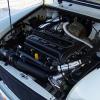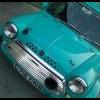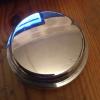Turbo injection
#31

Posted 16 December 2005 - 07:32 PM
I went to the T2 range back in 1999, and will never go to a t3... I'd be experimenting with the GT series before i'd do such a backwards step...
#32

Posted 16 December 2005 - 07:40 PM
Third item down
http://twminduction....tleBody-FR.html
#33

Posted 16 December 2005 - 07:47 PM
#34

Posted 16 December 2005 - 07:59 PM
My thoughts exactly ..... :erm:If you want drivability, why are you so against the T2?
#35

Posted 16 December 2005 - 08:02 PM
First rule of fluid dynamics -I agree, but in this situation where the fueling has to be exact the carb is never going to be good enough. It wont adjust when the air temperture rises and falls. Driving the motor around slowly ie around town, the under bonnet temperature will obviously increase and once up to speed and more cool air is flowing through the bay it will decrease. This will mean that the mix will just never be perfect. In my opinion, I would only ever use a high C/r and turbo on an 8 port or kad/Jack Knight16v where each outlet can be assesed and changed by the ECU and injectors to suit. There is just not enough control with a carb.
pressure, density and temperature are all related directly. Therefore it stands to reason that as air temp rises and falls so does the volume of air and along with this the amount of "depression" (in the carb) changes therefore drawing in more or less fuel respectively.
The only true way to gaurantee certainty with regard for fuel injection is to copy the Diesel and have direct injection straight into the cylinders.
Don't lets forget that no system is 100% efficient..
Ok so closed loop ECU fuelling using UHEGO's and HEGO's there is still lag between the system seeing a requirement to change and the actual change taking place, it may be short but its not 100%
It's all just a compromise....... :grin:
#36

Posted 16 December 2005 - 08:04 PM
If it is all so 'related' why is a bi-metallic strip added to the HIF carbs for raising and lowering the jet? Because air-temperature doesn't change a given air volume - just the oxygen content within a volume...
That's to say - 1m^3 of air at 20 degrees is 1m^3 of air - just as is 1m^3 of air at 100 degrees is still 1m^3. The oxygen content is significantly different... The carburettor doesn't know what it's drawing in - air, pure oxygen, co2, whatever...
Back to the throttle bodies, They must be fancy injectors if they provide enough fuel for 160hp with one injector per inlet tract!
MPI is over 450cc/min and you know how much power they DON'T put out - no matter what you do to them!
They look nicely made though! Still need a decent injector controllign strategy to meke them work really well however.
#37

Posted 16 December 2005 - 08:08 PM
#38

Posted 16 December 2005 - 08:23 PM
Seventh post down... I start explaining things (yet again!
Basically, a 4-inlet port engine can have one injector per inlet port. A 4-stroke engine takes 720 crank degrees to complete the cycle. Hence - has 720 crank degrees to inject the fuel needed.
An A-series shares the inlet ports.
It ends up that the inner cylinders theoretically(assume valves open and close at TDC/BDC) have 540 crank degrees, the outers 180 degrees. So - you have to home in on the outers as these are the problem ones.
So, you basically have 1/4 of the time to get the required fuel into the outer cyl's as you would in an 8-port motor.
REAL LIFE EXAMPLE:
Sierra cosworth fuel injectors ranged from 280 (ish) to 530 (ish) cc/min and make anything between 220 and 400 hp with the above. MPi mini had 460 (ish) cc/min injectors and has anyone ever seen one crack 90hp?
#39

Posted 16 December 2005 - 08:25 PM
Lets assume they can cope with this amount of fuel (160hp) then how well do they work at tick over ??They must be fancy injectors if they provide enough fuel for 160hp with one injector per inlet tract! MPI is over 450cc/min and you know how much power they DON'T put out - no matter what you do to them!
I know that there are some pretty special injectors currently being tested, however they use some very "fancy" control routines and are multi solenoid systems.
to get a "good" mix you require a fine spray mist, the less time you have for the injection phase (i.e. higher revs) the higher the pressure or the more injector holes or a combination of both ! once these avenues have been exhausted then the droplet size has to get bigger and therefore less efficient at becoming a "gas" by not mixing properely with the air charge.
Also your hego's may pick up that you have a rich mixture (large fuel droplets promote more unburnt fuel being exhausted) and "lean" off accordingly - not a very good idea as your pistons could well be relying on some spare fuel to keep them below melt down temperature.........
#40

Posted 16 December 2005 - 08:26 PM
BINGOREAL LIFE EXAMPLE:
Sierra cosworth fuel injectors ranged from 280 (ish) to 530 (ish) cc/min and make anything between 220 and 400 hp with the above. MPi mini had 460 (ish) cc/min injectors and has anyone ever seen one crack 90hp?
NAIL ON HEAD
FULL HOUSE
ST8 FLUSH
AND GOODNIGHT!
Alex
#41

Posted 16 December 2005 - 08:29 PM
You can't get over 400 odd with a single set of grey's can you???
(all from memory of a few years ago)!
#42

Posted 16 December 2005 - 08:35 PM
Thanks again.
#43

Posted 16 December 2005 - 09:01 PM
Hi Dave,MRA - I assume you've studied Thermodynamics at university if we're going to get into a more technical based discussion? I really dislike it when folks start 'raising the bar' without having even walked over it...
If it is all so 'related' why is a bi-metallic strip added to the HIF carbs for raising and lowering the jet? Because air-temperature doesn't change a given air volume - just the oxygen content within a volume...
That's to say - 1m^3 of air at 20 degrees is 1m^3 of air - just as is 1m^3 of air at 100 degrees is still 1m^3. The oxygen content is significantly different... The carburettor doesn't know what it's drawing in - air, pure oxygen, co2, whatever...
Back to the throttle bodies, They must be fancy injectors if they provide enough fuel for 160hp with one injector per inlet tract!
MPI is over 450cc/min and you know how much power they DON'T put out - no matter what you do to them!
They look nicely made though! Still need a decent injector controllign strategy to meke them work really well however.
How are you ? still happy I hope ?? :grin:
The actual composition of air is as follows:-
it varies little in percentage when heated or cooled (within reason) however the mass does change - overwise why bother to fit intercoolers ??
The bi-metalic strip is operated by air temperature is it ? I don't think so !
However I must appologise as I did go to university and in some peoples eyes I therefore am only fit to operate a broom !!!
Nitrogen N2 78.084%
Oxygen O2 20.947%
Argon Ar 0.934%
Carbon Dioxide CO2 0.033%
Neon Ne 18.2 parts per million
Helium He 5.2 parts per million
Krypton Kr 1.1 parts per million
Sulfur dioxide SO2 1.0 parts per million
Methane CH4 2.0 parts per million
Hydrogen H2 0.5 parts per million
Nitrous Oxide N2O 0.5 parts per million
Xenon Xe 0.09 parts per million
Ozone O3 0.07 parts per million
Nitrogen dioxide NO2 0.02 parts per million
Iodine I2 0.01 parts per million
Carbon monoxide CO trace
Ammonia NH3 trace
#44

Posted 16 December 2005 - 09:15 PM
Sadly, I don't remember numbers / stats... always been a problem of mine.
Back to the strip Did I say it was operated by air?
Nope.
But you can assume in whatever environememnt you're in that the temp of the fuel in the tank is similar to the atmospheric air temp...
eg - in californian heat, your fuel temp isn't going to be at 20degrees C. Equally, in Scotland in te winter, you won't have fuel at 80+ degrees.
Immersing it in the float chamber is the simplest (for opertating the jet). Sticking it in the airflow wouldn't be very clever as blatting along at 100 would be different to when sat idle in traffic...
#45

Posted 16 December 2005 - 09:24 PM
1 user(s) are reading this topic
0 members, 1 guests, 0 anonymous users
















